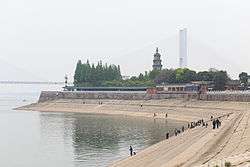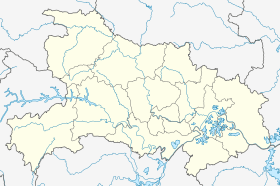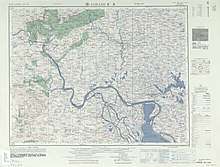Shashi District
Shashi (Chinese: 沙市; pinyin: Shāshì) is a district within the main urban area of Jingzhou, Hubei province, People's Republic of China. It is located on the left (northern) bank of the Yangtze River, between Yichang and Wuhan.
- See Shashi for namesakes
Shashi 沙市区 Shasi | |
|---|---|
District | |
 Jingzhou Wanshou Baota | |
 Shashi Location in Hubei | |
| Coordinates (Shashi Zhongshan Park (沙市市中山公园)): 30°18′58″N 112°15′07″E | |
| Country | People's Republic of China |
| Province | Hubei |
| Prefecture-level city | Jingzhou |
| Population (2010)[1] | |
| • Total | 600,330 |
| Time zone | UTC+8 (China Standard) |
| Website | www |
History
- Shashi was founded during the warring states period as an extension of the Chu capital Ying, its port on the Yangtze.
- In modern history it is notable as one of the four ports specified to be opened to the Empire of Japan in the Treaty of Shimonoseki (17 April 1895, which also ended Chinese imperial claims to Korea). The treaty port grew rapidly into because of this, gaining the moniker of "Little Hankow".[2] Nonetheless, the opening of other coastal ports led to trade moving elsewhere and it gradually declined.
In 1994 it lost its status as a city and was combined with Jingzhou to form Jingsha city.[3]
Administrative divisions

- Zhongshan Subdistrict (中山路街道/中山街道)
- Chongwen Subdistrict (崇文街街道/崇文街道)
- Jiefang Subdistrict (解放路街道/解放街道)
- Shengli Subdistrict (胜利街街道/胜利街道)
- Chaoyang Subdistrict (朝阳路街道/朝阳街道) (formerly: Lianhe Subdistrict (联合街道))
Four towns:
Ecclesiastical History
The Roman Catholic Apostolic Prefecture of Shashi or Shasi / Shasien(sis) (Latin adjective) was established on 7 July 1936, on territory split off from the then Apostolic Vicariate of Yichang (now a diocese), bordering on that, on the dioceses Hanyang and Puqi and on the Apostolic prefecture of Lixian.
It is a (dormant?) pre-diocesan Latin jurisdiction, which is exempt, i.e. directly subject to the Holy See and it missionary Roman Congregation for the Evangelization of Peoples, not part of any ecclesiastical province. No statistics available.
It is indefinitely vacant, without Apostolic administrator, since the death of its sole incumbent as Apostolic Prefect of Shashi :
- Father Julian Edward Dillon (狄隆), Friars Minor (O.F.M.) (born USA) (1936.07.11 – death 1961.06.25).
See also
References
- 沙市区历史沿革 [Shashi District Historical Development] (in Chinese). XZQH.org. 6 August 2014. Retrieved 19 June 2018.
2000年第五次人口普查,沙市区总人口591572人,其中:中山路街道59924人,崇文街街道49746人,解放路街道101798人,胜利街街道75314人,朝阳路街道111735人,锣场镇10715人,岑河镇51480人,观音垱镇46943人,立新乡18583人,关咀乡15846人,西湖管理区7238人,沙市农场14027人,荆州高新技术产业开发区28223人。{...}2010年第六次人口普查,沙市区常住总人口600330人,其中:中山街道57566人,崇文街道51208人,解放街道85584人,胜利街道75002人,朝阳街道58834人,联合街道88308人,锣场镇9927人,岑河镇47121人,观音当镇34010人,关沮镇15841人,立新乡55505人,岑河原种场7928人,沙市农场13496人。
- 荆州 一个几乎被遗忘的"楚国故都". todayonhistory.com (in Chinese). Retrieved 13 January 2016.
- 中華人民共和國行政區劃(1994年). big5.gov.cn (in Chinese). Retrieved 13 January 2016.
- 2016年统计用区划代码和城乡划分代码:沙市区 [2016 Statistical Area Numbers and Rural-Urban Area Numbers: Shashi District]. National Bureau of Statistics of the People's Republic of China. 2016. Retrieved 19 June 2018.
统计用区划代码 名称 421002001000 中山街道办事处 421002002000 崇文街道办事处 421002003000 解放街道办事处 421002004000 胜利街道办事处 421002005000 朝阳街道办事处 421002100000 锣场镇 421002101000 岑河镇 421002102000 观音当镇 421002103000 关沮镇 421002200000 立新乡
- 行政区划 [Administrative Divisions] (in Chinese). Shashi District People's Government. Retrieved 19 June 2018.
2016年,沙市区辖立新乡、关沮镇、锣场镇、观音垱镇、岑河镇等5个乡镇和解放路街道办事处、崇文街街道办事处、中山路街道办事处、胜利街街道办事处、朝阳路街道办事处等5个办事处,